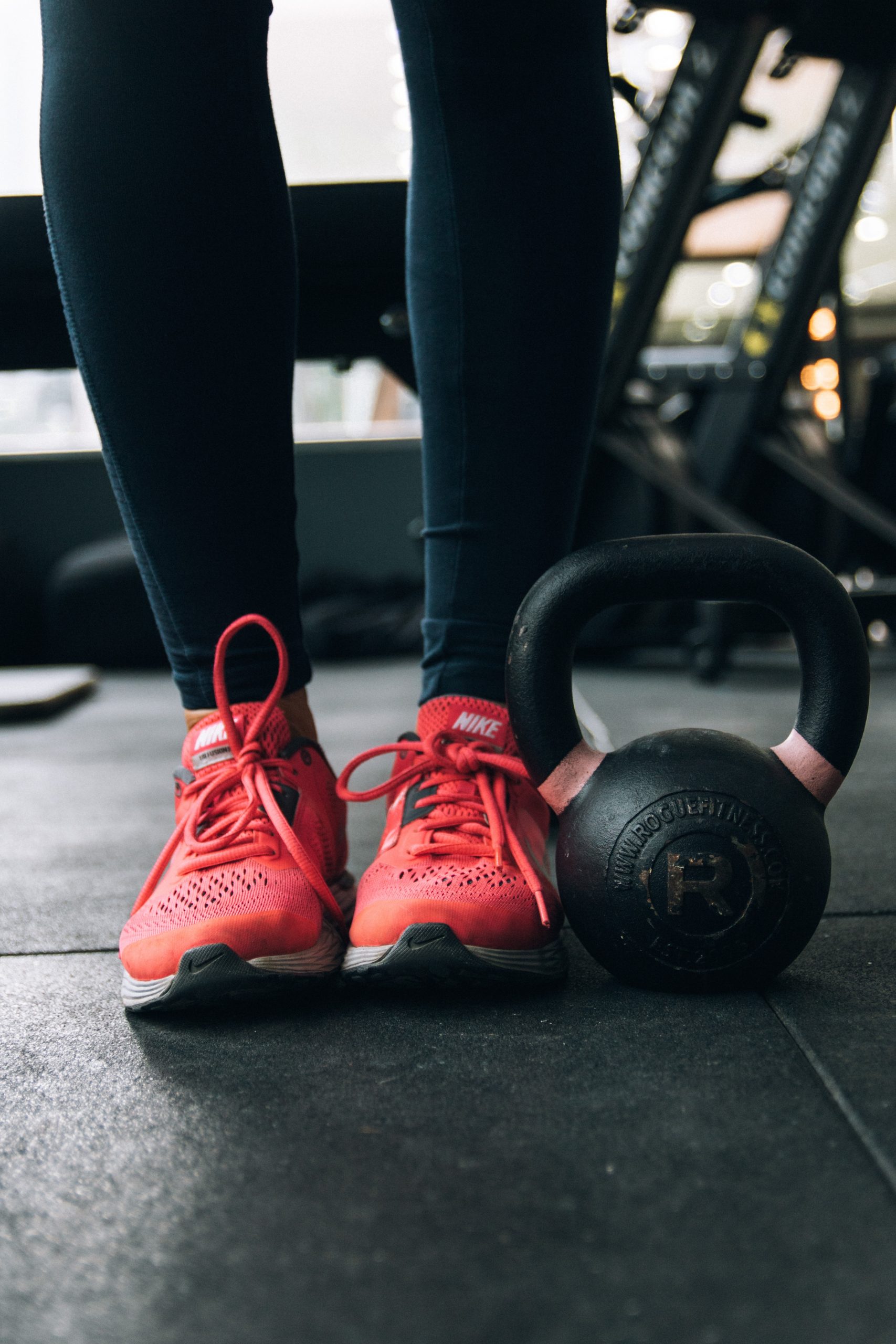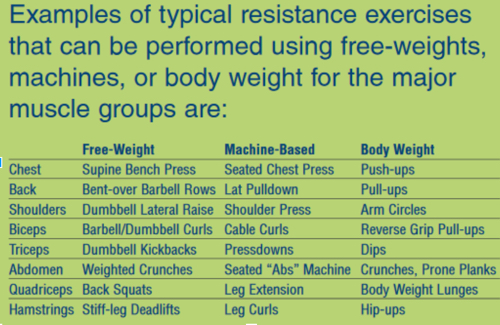5 1.5 Physical Activity Guidelines and Recommendations
Various professional associations have published physical activity guidelines which may assist individuals in designing personal fitness programs. Selected publications which will be comprehensively examined include: Physical Activity Guidelines Advisory Committee Report, 2008, American College of Sports Medicine Position Stand, and recommendations from the American Heart Association and the President’s Council on Fitness, Sport, and Nutrition.
2008 Physical Activity Guidelines for Americans
A review of current scientific literature was examined in the Physical Activity Guidelines Advisory Committee Report, 2008 in order to provide the public with information regarding the effects of physical activity in reducing chronic disease risk and all-cause mortality, while improving health. The report provides in-depth information detailing the impact physical activity has upon: cardiorespiratory health, metabolic health, energy balance, musculoskeletal health, functional health, cancer, mental health, and a variety of related topics. The results have been stratified for a variety of diverse populations, and age ranges (Physical Activity Guidelines Advisory Committee, 2008).
The following physical activity guidelines for healthy, adult populations have been provided by the Physical Activity Guidelines Advisory Committee Report, 2008. The guidelines include specific recommendations for both aerobic physical activity and resistance training.
- Individuals should avoid physical inactivity. Engaging in small amounts of physical activity is preferable to no activity, with minimal engagement in exercise still resulting in some health benefits (Physical Activity Guidelines Advisory Committee, 2008; Office of Disease Prevention and Health Promotion, 2016).
- …it is recommended that adults engage in at least 150 minutes (2 hours, 30 minutes) of moderate-intensity aerobic physical activity per week, or 75 minutes (1 hour, 15 minutes) of vigorous-intensity aerobic physical activity per week.For substantial health benefits, it is recommended that adults engage in at least 150 minutes (2 hours, 30 minutes) of moderate-intensity aerobic physical activity per week, or 75 minutes (1 hour, 15 minutes) of vigorous-intensity aerobic physical activity per week. An equivalent combination of moderate- and vigorous intensity aerobic activity may be done to meet the recommendations (Physical Activity Guidelines Advisory Committee, 2008; Office of Disease Prevention and Health Promotion, 2016).

Current physical activity guidelines recommend that healthy adults engage in at least 150 minutes of moderate-intensity, or 75 minutes of vigorous-intensity, physical activity on a weekly basis. Moderate and vigorous intensities are often determined utilizing an individual’s heart rate (Section 1.2). Photo by aquachara on Unsplash. Note: Aerobic activity may be separated into bouts of at least 10 minutes in order to meet the total number of minutes per week. If aerobic activity is done in short bouts, these bouts should be spread out evenly throughout the week.
Comprehension check:
How could you personally reach the recommendations for minutes engaged in moderate- or vigorous-intensity aerobic physical activity per week? Create a weekly calendar which outlines your plan.
- For additional health benefits, it is recommended that adults increase engagement in aerobic physical activity to 300 minutes (5 hours) of moderate-intensity aerobic physical activity per week, or 150 minutes (2 hours, 30 minutes) of vigorous intensity aerobic physical activity. An equivalent combination may be done to meet the recommendations, and further health benefits attained by engaging in physical activity exceeding this amount (Physical Activity Guidelines Advisory Committee, 2008; Office of Disease Prevention and Health Promotion, 2016).
- Adults should engage in resistance training (muscle-strengthening activities) on 2 or more days throughout the week. These muscle-strengthening activities should be moderate or high intensity, and involve all major muscle groups of the body (Physical Activity Guidelines Advisory Committee, 2008; Office of Disease Prevention and Health Promotion, 2016). In-depth resistance training guidelines are provided within the ACSM Position Stand and Recommendations section of this chapter.

Examples of moderate-intensity aerobic physical activity: brisk walking, dancing, swimming, cycling, and yard work. Jogging or running activities are often categorized as vigorous-intensity aerobic physical activity. Resistance training could include a variety of activities, such as training with body weight exercises, free weights, or resistance bands.
Comprehension check:
What resistance training exercises could you personally do to reach the recommendations? Create a weekly calendar which outlines your plan.
Notably, these recommendations are appropriate for the majority of the healthy, adult population. However, each individual may have unique health concerns which impact their level of engagement in physical activity. The full Physical Activity Guidelines Advisory Committee Report, 2008 is available for the interested student at: https://permanent.access.gpo.gov/gpo23524/CommitteeReport.pdf.
ACSM Position Stand and Recommendations
The American College of Sports Medicine Position Stand: The American College of Sports Medicine (ACSM) provides recommendations which are consistent with the Physical Activity Guidelines Advisory Committee Report, 2008 regarding aerobic physical activity and resistance training guidelines. However, the ACSM position stand provides additional recommendations for flexibility and neuromotor exercise (Garber, et. al., 2011).
- Flexibility exercise: Healthy adults should engage in flexibility exercises at least 2-3 days per week. Each stretch should be held 10-30 seconds each, repeated 2-4 times for a total of 60 seconds (Garber, et. al., 2011).
- Neuromotor exercise: Healthy adults should engage in exercises which enhance motor skills (i.e. balance, agility, coordination) 2-3 times per week, for a duration of 20-30 minutes each bout (Garber, et. al., 2011).
Comprehension check:
Create a weekly physical activity calendar which includes flexibility and neuromotor exercises, meeting the ACSM recommendations.
Resistance Training Factors: Resistance training (engaging in muscle-strengthening activities) is most effective when a variety of major muscle-groups are targeted. Several major muscle-groups include (but are not limited to): chest, back, shoulders, biceps, triceps, abdominals, quadriceps, and hamstrings (American College of Sports Medicine, 2013a; American College of Sports Medicine, 2013b).
ACSM resistance training guidelines recommend that each resistance exercise should be performed for 8-12 repetitions, for a volume of 1-4 sets depending on specific goals of the muscle-strengthening program. Rest periods should be observed in-between sets (American College of Sports Medicine, 2013a; American College of Sports Medicine, 2013b). These recommendations apply to healthy, adult populations.
Resistance training programs may differ greatly depending upon an individual’s specific goals related to muscular strength, muscular power, muscular hypertrophy (growth), or muscular endurance.Resistance training programs may differ greatly depending upon an individual’s specific goals related to muscular strength, muscular power, muscular hypertrophy (growth), or muscular endurance. The frequency of training must be closely monitored in order to avoid overtraining (American College of Sports Medicine, 2013a; American College of Sports Medicine, 2013b).
An example of a resistance training program which targets major muscle groups utilizing free weights, machines, or body weight is demonstrated in Figure 2.

https://www.acsm.org/docs/brochures/resistance-training.pdf
Additional Physical Activity Recommendations:
American Heart Association: The American Heart Association (AHA) provides recommendations which are consistent with aforementioned physical activity guidelines from the Physical Activity Guidelines Advisory Committee Report, 2008 for overall health benefits. The AHA recommends additional minutes of moderate- or vigorous-intensity aerobic physical activity be performed per week to reduce blood pressure and cholesterol (American Heart Association, 2014).
President’s Council on Fitness, Sport, and Nutrition: The President’s Council on Fitness, Sport, and Nutrition is an additional free resource for the interested student.18 This resource provides the public with information on: why physical activity is important, ways to be active, the Sport for All initiative, the Physical Activity Initiative, and a summarization of the 2008 Physical Activity Guidelines for Americans.
The above information may be accessed at: https://www.fitness.gov/be-active/.
Works Cited
American College of Sports Medicine. (2013a). ACSM’s guidelines for exercise testing and prescription. Lippincott Williams & Wilkins.
American College of Sports Medicine (2013b). Resistance training for health and fitness [Brochure]. Retrieved December 20, 2016 from https://www.acsm.org/docs/brochures/resistance-training.pdf
American Heart Association (2014). Healthy living: American Heart Association recommendations for physical activity in adults. Retrieved from http://www.heart.org/HEARTORG/HealthyLiving/PhysicalActivity/FitnessBasics/American-Heart-Association-Recommendations-for-Physical-Activity-in-Adults_UCM_307976_Article.jsp#
Garber, C. E., Blissmer, B., Deschenes, M. R., Franklin, B. A., Lamonte, M. J., Lee, I. M., Nieman, D., & Swain, D. P. (2011). American College of Sports Medicine position stand. Quantity and quality of exercise for developing and maintaining cardiorespiratory, musculoskeletal, and neuromotor fitness in apparently healthy adults: guidance for prescribing exercise. Medicine and science in sports and exercise, 43(7), 1334-1359.
Office of Disease Prevention and Health Promotion (2016). Physical activity guidelines: 2008 physical activity guidelines for Americans summary. Retrieved from https://health.gov/paguidelines/guidelines/summary.aspx
Physical Activity Guidelines Advisory Committee. (2008). Physical activity guidelines advisory committee report, 2008. Washington, DC: US Department of Health and Human Services, 2008, A1-H14.

